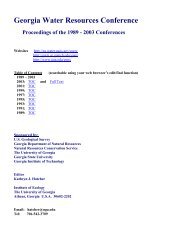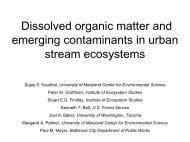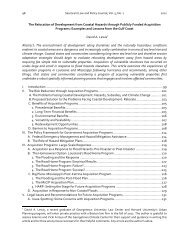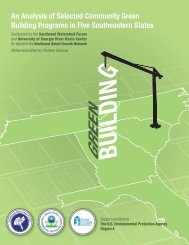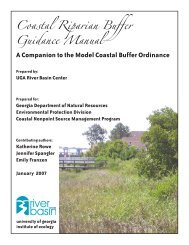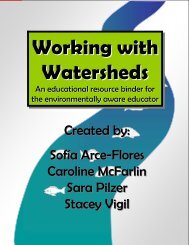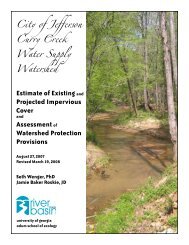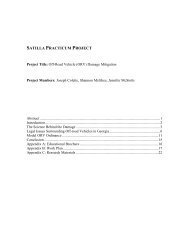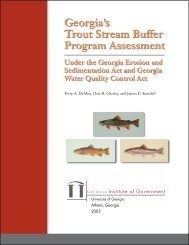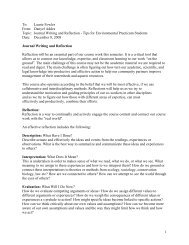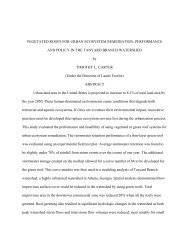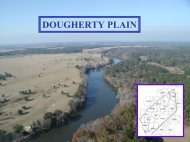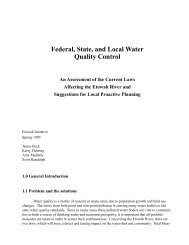1 Bibliographic Review of Sources Relevant to Development of Draft ...
1 Bibliographic Review of Sources Relevant to Development of Draft ...
1 Bibliographic Review of Sources Relevant to Development of Draft ...
Create successful ePaper yourself
Turn your PDF publications into a flip-book with our unique Google optimized e-Paper software.
Savannah River Annotated Bibliography: January 2003<br />
Goodwin, W.F., and Adams, J.G. (1969). Young Clupeids <strong>of</strong> the Altamaha River,<br />
Georgia. Georgia Game and Fish Division. Marine Fisheries Division. Brunswick,<br />
Georgia.<br />
In the Altamaha River, juvenile American shad were first collected in April.<br />
Juveniles migrated out <strong>of</strong> the river by January and blueback herring migrated out by<br />
Oc<strong>to</strong>ber. American shad migrations out <strong>of</strong> the river system do not correlate with<br />
decreasing water temperatures. Shad migration is probably size dependent. Hickory<br />
shad probably don’t use the river as nursery area, but migrate <strong>to</strong> <strong>of</strong>fshore waters<br />
following hatching. A good review <strong>of</strong> juvenile clupeid movement in the Altamaha<br />
River is presented here.<br />
O'Leary, J.A. 1984. Characteristics <strong>of</strong> the Downstream Migration <strong>of</strong> Juvenile American<br />
Shad (Alosa sapidissima) and Blueback Herring (Alosa aestivalis) in the Connecticut<br />
River. University <strong>of</strong> Massachusetts Master's Thesis. 58p.<br />
Downstream migration <strong>of</strong> juvenile American shad and blueback herring was studied<br />
in the Connecticut River. Migration peaked during the new moon phase in Oc<strong>to</strong>ber.<br />
American shad diel patterns showed a peak in the late afternoon <strong>to</strong> evening <strong>of</strong> both<br />
years and blueback herring during the daytime.<br />
Paller, M.H., and B.M. Saul. 1996. Effects <strong>of</strong> temperature gradients resulting from<br />
reservoir discharge on Dorosoma cepedianum spawning in the Savannah River.<br />
Environmental Biology <strong>of</strong> Fishes. 45, 151-160.<br />
Hypolimnetic release from Strom Thurmond Reservoir created a downstream<br />
temperature gradient in the Savannah River. Gizzard shad Dorosoma cepedianum<br />
spawned earlier in the season in the warmer reaches <strong>of</strong> the river downstream and<br />
later upstream. Gizzard shad larvae peaked when water temperatures reached<br />
approximately 19 C. Temperature range for spawning is 10-29 C. When water<br />
levels were high and low in the floodplain swamps and backwaters (April and May<br />
<strong>of</strong> 1983 and 1984), larval densities were high. However, declining water levels and<br />
emigration may have influenced densities. Floodplain swamp water levels were high<br />
in April, 1983 and low by May 1983 (see floodplain innundation in fig 6.).<br />
Probst, W. 1988. Evaluation <strong>of</strong> Successive Year Class Strength <strong>of</strong> Juvenile American<br />
Shad in the Ogeechee River. Georgia Department <strong>of</strong> Natural Resources. Game and<br />
Fish Division. Altanta Georgia.<br />
In Georgia the American shad spawning run begins in January and continues in<strong>to</strong><br />
April. Young shad remain in their natal rivers the first summer and migrate <strong>to</strong> the sea<br />
in late summer. Juvenile shad appeared <strong>to</strong> be more active in the daylight.<br />
Outmigration may be triggered by temperature.<br />
Stier, D.J., and J.H. Crance 1985. Habitat suitability index models and instream flow<br />
suitability curves: American Shad. U.S. Fish and Wildlife Service Biological Report.<br />
82(10.88). [accessible at http://www.wes.army.mil/el/emrrp/emris/EMRIS_PDF/<br />
other riverine species available at this site, <strong>to</strong>o.]<br />
The Habitat Suitability Index Models developed by Crance (1986) and Stier and<br />
Crance (1985) for the American shad and shortnose sturgeon were modified and<br />
used in the Savannah River Instream Flow study (ENTRIX, 2002b) <strong>to</strong> examine<br />
spawning, egg and larval drift, and adult habitat suitability under various flows. The<br />
habitat suitability index model for the American Shad has life his<strong>to</strong>ry information as<br />
42



